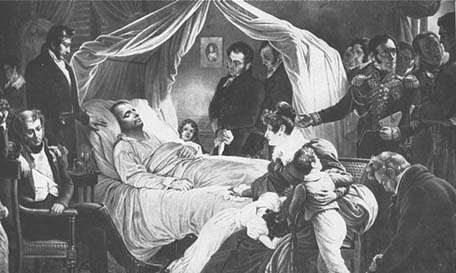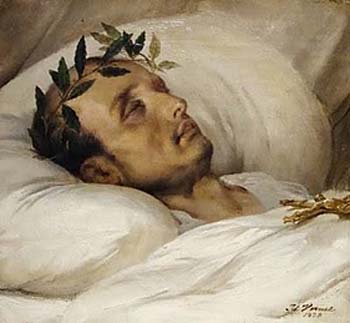The Surgeon’s Blade: Dents and Diseases – Bonaparte’s Health
December 20, 2018 - Mick Crumplin in News & Blog Posts, The Surgeon's Blade
In his latest medical blog, Mick Crumplin discusses the health of Napoleon
Of the three greatest heroes of the long wars against France and Napoleon, Nelson, Bonaparte and Wellington, only Nelson was to die in action. Nelson had suffered many illnesses and injuries during his short existence, arguably being most forward in close action. Wellington was clearly a fit man and infrequently ill. Also with good fortune, he had only occasionally been lightly injured – at Salamanca and Orthez.
Both Wellington and Napoleon had never shirked at being all over the field and at considerable risk, thus it was indeed remarkable that both survived the long wars which had been prosecuted in diverse nations and often unhealthy climates. Nelson died a heroic death at the peak of his career, so avoiding a long post-war life of potential scandal. Wellington campaigned hard and successfully in diverse military situations and in controversial politics. He had died at a ripe old age (for then) of 83, peacefully in Walmer Castle.
Not so the French Emperor, who left this earth at the earlier age of 52 years. Bonaparte had a pretty miserable life after Waterloo. He had failed to ensure his dynasty and was securely imprisoned on a rather bleak south Atlantic volcanic outcrop, St Helena. His health has provided scores of historians with controversial debates. He was always a rather sallow and pale youth, bullied at school, he presumably had a reasonably healthy childhood. It was said that he had suffered from tuberculosis in his early years, whether this was picked up from another person by aerosol inhalation or drinking infected milk, we will never know.
Later in life, his attitude to the medical profession was occasionally (and understandably) sceptical, but in the main, supported meritorious doctors and any reasonable innovations. The only medical procedure that he submitted to, as far as I know, was a dental extraction, carried out by Dr Barry O’Meara, on St Helena.
His wounds were simple enough and few in number. On December 17 1793 during an assault on a fortified position, at the Siege of Toulon, either a sergeant of the Royal Irish Regiment or a British gunner inflicted a bayonet (or pike) wound on the inner side of Bonaparte’s left thigh, just above his knee. We know little of this wound, which probably did not involve major bony injury or significant damage to blood vessels or nerves, but it was said that amputation had been considered. The wound became septic and intermittently discharged purulent material. Perhaps there were retained cloth or bone fragments. Decades later, on St Helena, in front of Dr Antomarchi, his attendant physician, he was able to pull open the wound, which discharged some thin serosanguinous material. He also contracted scabies (La Gale) during the artillery action at Toulon. In 1798, during the Egyptian campaign, he was kicked in the right leg by his horse. This caused some bruising and a collection of old blood which was drained by Surgeon Larrey.
During Bonaparte’s post-mortem, Antomarchi reported two scars on his left leg which came about as a result of a wound suffered at Marengo in 1800, where his left boot was damaged by a tangential strike by a round shot. In April of 1809, a toe was damaged at the action of Eckmühl and the following day, at the Siege of Ratisbon, he received another injury, when a small spent case round or bullet struck his right (or probably his left) ankle behind the prominence of the malleolus. This caused some bruising. His wound was dressed by his Surgeon Alexandre Yvan, who advised that a chunk of leather should be cut out of his riding boot, to prevent painful chafing of the wound.
(above) Bonaparte at Toulon (Author’s collection) Napoleon injured at Ratisbon (Author’s collection)
Aside from these few minor injuries, there were other medical challenges for the Emperor. His campaigns had taken him to Northern Italy, Egypt, Iberia, Russia and much of Central Europe. Diseases that decimated armies, such as dysentery, typhus, typhoid, ophthalmia, venereal problems, bubonic plague and smallpox were frequent and serious threats. Andrew Roberts in a recent publication has made an extensive list of diseases attributed to Bonaparte. Some of the endocrine disorders attributed to Bonaparte would be impossible to prove. It is unlikely he escaped dysentery, viral chest infections and possibly venereal disease, over his many travels, climatic exposures and his love life. There is no proof that he ever contacted gonorrhoea, which was no respecter of rank, status or fortune! One medical researcher has postulated that Bonaparte had exhibited over 20 clinical manifestations of syphilis.
“His longstanding haemorrhoids are not in dispute”
Bliharzial infestation was, and still is not infrequent in Egypt, around the Nile delta and would give possible reason for his small bladder calculi found at post-mortem and attacks of cystitis. There were occasions, for example in Russia, when Bonaparte spent overlong urinating and whether this was due to a stricture (narrowing) of the urethra or strangury (painful and a sense of incomplete micturition, due to his bladder stones), we shall not ever know. He certainly suffered from a fever and was clearly not that well shortly before Borodino. Much doubt has been expressed over Bonaparte’s tendency to epilepsy. He certainly had some form of paroxysmal seizures, witnessed by Marguerite Georges, Talleyrand and a valet de chamber, but these did not show some of the usual characteristics of epilepsy. His longstanding haemorrhoids are not in dispute and, as we learned from Prince Jerome’s diary, he certainly had at least a score of leeches applied to the Imperial perineum during the Waterloo campaign.
His other main challenge to health and performance as the years wore on was fatigue and stress. A prodigious worker, hours in the saddle, little enough sleep had all posed a potential threats to his performance, despite his seemingly limitless energy. One might say that is was remarkable that he lived as long as he did, never succumbing to a stroke or myocardial infarction. In his family history, it is of note that his father died in his mid-thirties of gastric cancer, as probably did one of his sisters, Pauline.
During the Waterloo campaign, British and foreign historians have conjectured that the Emperor was in poor health, with inevitable tactical consequences. We will never know for sure how ill he felt, particularly as he had to put up an overconfident front between June 16 and 18, 1815, but we can be sure that he had anal discomfort, which made riding uncomfortable. Also with the knowledge that he fell asleep or dozed on the field at times and had at one stage retired to Rossome, he was exhausted. He surely was not at his very best, but still very capable. Concession has to be given, however that he was used to little sleep, probably used ‘power naps’ and had a very experienced mind even under such stresses.
“We can be certain that he had a genetic predisposition to stomach cancer”
On St Helena, his general health had taken a down turn and he was depressed and ate poorly. O’Meara was a physician trusted by Bonaparte, and he was convinced that the Emperor had a form of hepatitis. Hudson Lowe had been suspicious of O’Meara’s links with Napoleon and cared not for the doctor’s diagnosis of hepatitis, since this might infer that Britain had purposely placed the Emperor in an unhealthy environment, so jeopardising his existence. Lowe had O’Meara replaced and eventually sent home, suspecting the doctor of undue sympathy with his notorious patient. Inevitably, with the depression and frustrations of Bonaparte, there were a myriad of hypochondriacal symptoms – headache and many aches and pains in the chest and limbs.
One thing is certain and that is that Napoleon was terrified of dying with the fatal disease from which his father suffered. We can thus be certain that he had a genetic predisposition to stomach cancer. Also dietary factors could have played their part, particularly in the cooking and preservation of what he ate. Bonaparte might well have had gastric infestation with the organism Helicobacter Pylori, which could well have given rise to a predisposition to a chronic pre-pyloric gastric ulcer and later, the cancer.
Notorious theories of poisoning by arsenic vapour emanating from the damp green wallpaper at Longwood or disloyal members of the house’s coterie have provided much discussion and speculation and any ultimate surgical and histological proof of the Emperor’s final disease is sadly lacking. It would be churlish indeed not to mention the work of Dr Ben Weider, a most committed and wealthy Napoleonic historian and collector. He was convinced and spent a vast amount of money, trying to prove the theory of intermittent arsenical poisoning, possibly by Count Montholon and others. What gave a degree of gravitas to Weider’s committed conspiracy theory was the similarity of some symptoms and signs of arsenical poisoning to those of gastric cancer.
Unfortunately, during the preservation of the body for burial, at which the imperial internal organs were removed, we simply do not know of the disposal of the Emperor’s liver, spleen, kidneys, pancreas stomach and intestines, which had been placed in silver vessels. The diagnosis of some form of hepatitis can never be proven and the rather unremarkable Imperial liver may have been slightly enlarged. At one time the English College of Surgeons had possession of some of Bonaparte’s small intestine, but the providence of this eventually proved unreliable.
If we muster the facts to resolve this pathological conundrum, we are left with little doubt that with the family history, symptoms, clinical course and autopsy, the findings of a relatively advanced carcinoma of the stomach and a smaller adjacent ulcer, more likely benign, are of little surprise. Added to this evidence, were two other interesting pieces of study to boost the diagnosis of cancer. Firstly, the levels of arsenic in other contemporary persons’ hair samples had proved to be not dissimilar to the Emperor’s own concentrations. Secondly, the proof that Bonaparte, contrary to Ben Weider’s claims, had lost weight, despite having more body fat that many people of the period.
(above) One of several images of Bonaparte showing clear weight loss (Source unknown)
This was cleverly thought out by a group of medical researchers from Basle. They determined a probable weight loss of around three stone. They achieved this by measuring a consecutive series of diminishing waist measurements on the Emperor’s breeches over months and years.
Bonaparte had filled his young life with glory, considerable lasting benefits for a ruptured France and sometimes impressive strategic and tactical skills. How much more Kudos would he have gained had he been killed leading his Imperial Guard up the slopes of Mont St Jean on June 18 1815?





